Testimonies
Here is a selection of testimonies submitted to us via e-mail or Facebook, and originally published on our Hungarian-language website. These testimonies were selected and, unless stated otherwise, translated into English by Gwen Jones. To submit a story, please write to bertalan@ceu.edu.
2014. February 18., Tuesday
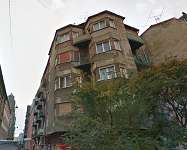
I grew up in this house, and lived here during the Holocaust too. My father was taken away from here on forced labor service and he never returned.
Most of the house’s residents were Jewish, and even before that time too. I’ll try to mention them by name, so that a trace of them remains in the wider world. We lived on the first floor in no. 1, and although I don’t remember the name of the tenants in no. 2 next door, after the war, the actress Margit Dajka moved in there and stayed for many years. At no. 3 on the first floor lived the Somlai family, whose earlier family name was Sreier. The husband (Uncle Rudi) worked in some office, while his wife, Auntie Zsóka, was a seamstress, and the apartment also contained her salon and workshop.
At no. 1 on the second floor lived the Fekete family, who somehow survived the Holocaust. Auntie Fekete had three sons: György went off to somewhere in South America, from where his letters arrived, and there was always some big celebration. The middle son János went to Austria, and the third, István, stayed at home with his mother. The mother and youngest son both died at home some years after the war. On the second floor also lived the Paszternák family, who left in 1956. They had two sons, Róbert and Detre. The Meizl family also lived on the second floor, the mother survived the Holocaust, and Rózsika, in her twenties, died during deportation.
The Bánáti family lived on the third floor, the husband worked in the textile industry, and they also survived the war. On the same floor lived the Dános family, and they too survived somehow. I don't know how many there were in the family, or who survived, but I do know that their son Tamás defected to America. The owner lived on the fourth floor, we called him Uncle Bíró, I don't know his first name. After he died, Egon Lázár moved into the apartment, I think he was the finance director of the Opera or the Comedy Theater, so he was a relative. Otherwise the Sinkovics-Gombos couple also lived in the house for a while, with their children. I don't remember anyone else, but perhaps that's enough about the house.
2014. February 05., Wednesday
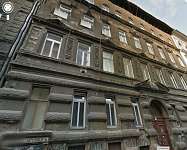
When we had to move in according to the decree, my father was on forced labor service but somehow managed to arrange for his sister and her son to move in together with us. Relatives of my aunt’s husband took us in at their three-room apartment on Ó Street, where there were at least 20 of us crammed together. Of course, most of them slept on the floor. Apart from me and my cousin (we were 10 and 11 years old) there was another child, who was 2 or 3. We lived in permanent fear because of the news going round that they would take us away, but I don’t remember whether there was any talk of where they’d take us to. But if a lorry stopped in the street, we got dressed and put on lots of layers of clothing, because we’d heard we couldn’t take any belongings with us. There were many children in the house, and we played in the courtyard almost the whole day. At night people had to be on air raid alert and wake people if the air siren started. It was mostly elderly men and a few women who did this, and the women were terribly frightened of being outside at night, because that’s when the cockroaches came out.
There were a few hours every day when we could go out and shop, and we would go with my mother, always hiding the yellow star, because my mother suffered greatly because of it.
On October 15, which fell on a Sunday, my father who had been on forced labor service got one day’s leave and came home to see us. That was the last time I saw him because after the Arrow Cross takeover of power was announced on the radio, we begged him not to go back, but stay with us, so at least we’d be together, whatever happened. Sadly, he didn’t stay: their commander announced that if anyone didn’t return, the rest would be decimated. He would never have wanted this on his conscience.
After this, one of our relatives who had taken part in rescuing Jews organized a Swiss protection passport for the four of us, with which we could move into the protected camp at Columbus Street. And so my mother, aunt, cousin and I Ieft the yellow-star house.
But that’s another story, full of suffering.
What concerns this story is that the concierge was an exceptionally decent person and never gave anyone up. For example, if someone came back after the curfew, he still opened the gate for them. But his greatest “deed” was when we were already in hiding and had nowhere to go, he let us back into the house and hid us in the basement in the evening, since the apartment had already been occupied by the Germans or the Arrow Cross. This happened on two occasions, and the second time, he woke everyone up at dawn and told us to disappear because there was going to be a raid.
Dr. Olga Sólyom (then Schwarz)

“I don’t believe it! Granddad, you forgot that too!” said my nine-year-old grandson when I was telling him about the distant past at one of our recent family gatherings.
And I really had!
I can’t believe it either, how could I have forgotten those few weeks, few months, that I spent in the yellow-star house at Nefelejcs Street 47. I remember every nook and cranny of the house, as I lived there right up until 1959, but barely remember anything from the early period.
I don’t know how we ended up there, they either took us or we went on foot. I know that we had to leave Nefelejcs Street 27-29, because the Jews had to move in together. They decided what we could take with us, and what we could leave behind. Nefelejcs Street 47 was one of the designated yellow-star houses, a small two-story semi-detached house with an external corridor and, in the courtyard, a separation wall about 2 meters high, where no. 49 started.
The house belonged to a married Jewish couple of retailers, the Flamms, who had a cobblers’ shop next to the front gate. Mrs. Flamm also lived in the house on the first floor in the nicest and largest apartment in the house, the only one to have an inside WC. A large six-pointed star hung near the gate, but I don’t remember where.
We were in apartment no. 5 on the ground floor, with my mother, grandmother and grandfather, my younger sister Zsuzsika, my mother’s sister and her son. There were so many of us because my aunts and uncles joined us. The apartment had a small kitchen and alcoved room, underneath was the musty cellar, and next door was the moldy shared WC. The kitchen could only be aired by opening the door, and at the back of the room there was a window that looked onto a wall. The kitchen door was next to the WC passageway.
I remember only one event from those times, one that caused great alarm. One day Mrs. Bodor went to see who was banging on the front gate; she was the concierge who kept a large dog. In front of the gate stood a man in uniform who said he was looking for Mrs. Schwarcz. His uniform looked like the Arrow Cross uniform, and Mrs. Bodor shouted into the courtyard, “Mrs. Schwarcz, they’ve come for you!” The man was already in the courtyard, and by the time Mrs. Bodor had told him which apartment to go to, he was already outside our door. We were shaking with fear, but Mother didn’t show her fear, sent us into the room, and let the man in. In the kitchen, they fell into one another’s arms, as soon as my mother recognized Irénke Weisz’s fiancé, Sándor.
Sándor had escaped from forced labor service and was a member of one of the resistance groups, and had come to see us and practice the violin with me. He was a great violinist, and I’d already been learning on a child’s violin, which we had brought with us to the yellow-star house. The next day, he came again and brought us some food and a violin in its case. When he left, my mother put the violin case in the wardrobe under the bedding. On the third day he visited, nobody was afraid of him any more, and particularly us, since we knew who he was. He left and took the violin case with him, and we didn’t see him again until the end of the war. At some point in 1945 he appeared again with Irénke, they said their goodbyes and emigrated to Israel. It was then he told my mother me the great secret that the violin case had contained weapons. She didn’t know what or how many, and was too afraid to ask or even take a look. This story remained a secret in the family for many years. My little violin was up on the wall with its bow for many years!
We didn’t want to be “heroes!”
Some time in the 1990s, Sándor came home to visit and we talked about this story. I gave him my little violin as a present!
When I think of those times, it’s the house at Nefelejcs Street 47 that comes to mind. It’s interesting that I was the same age then as my grandson is now!
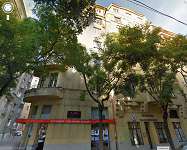
At the end of October, only people with "Schutzpass" protection documents could stay in the house. We were taken to Pannónia Street 56, and from there in early November to Népszínház Street 22, and then later to the Ghetto.
We went along Rákóczi Road towards Klauzál Square, and the crowds of people on the street looked on maliciously, many of them shouted in approval. At Klauzál Square we had to throw all jewelry into a box, individuals were searched, and then they pointed out where we were going to live.
I was born in 1936 and regard what is happening today as the falsification of history. Because I also remember that when the German occupation began (which was on a Sunday), nobody despaired, what I saw on people was indifference.
Respectfully,
Dr. Gyula Erdős
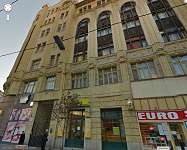
From April 1944 my mother left the house at Népszínház Street 31 to give birth.
I was born in Budapest on May 13. My mother gave birth in the 8th district hospital on Alföldi Street and as long as she lived, often told the story of how Jewish mothers were only given chicory coffee replacement, while non-Jewish mothers were well looked after and drank coffee with milk. She told me that the nurses always pointed out what a lovely baby I was, but that it was a shame I was Jewish. She went into hiding even while pregnant, because my father was not Jewish and according to the laws of the time, could not marry her. When we left the hospital we wanted to go to my father’s parents but they were afraid and sent us away, and then my mother didn’t dare return to the yellow-star house, so we hid until the Soviets arrived.
While in hiding my mother saw the Arrow Cross taking Jews to the Danube to be shot. Her aunt was there in the crowd, and she wanted to speak to her, but the aunt put her hand in front of her mouth and signaled to be quiet, so that my mother wouldn’t be taken away too.
I would also like to mention that I have had to hide the fact I am Jewish until today, because we don’t know when it will happen again in this country. We had to hide our origins until 1989 because there were lots of antisemites in the Hungarian Socialist Workers’ Party and nothing much changed after 1989. Today, Fidesz’s falsification of history is more frightening than Jobbik’s antisemitism.
Fidesz uses double-speak because they glorify and excuse Horthy, while erecting statues, and naming squares and streets after him. Today I read for the first time that the information about the yellow-star houses has been made public and I am pleased that you are bravely facing Fidesz’s low-down politics.
Regards, a survivor.
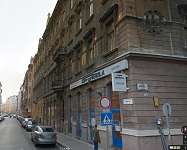
My mother (Györgyike Mérő) and her mother (Mrs. Ignác Mérő, born Janka Schön) were moved into Lónyay Street 15. I’m not sure, but I think that my mother’s aunt (Mrs. Sárkány, born Cecília Morgenstern, or Auntie Cilka to the family) was already living in the house and they all moved in together. My grandmother was 48 at the time, my mother 19. The other family members were not with them because…
On the second day of the German occupation, March 20, 1944, my grandfather (Ignác Mérő, earlier Morgenstern) was taken prisoner by the Gestapo in the Astoria Hotel because he was a social democrat. From Sváb Hill a straight road led him and his colleagues together to Mauthausen. K. Rátkai’s book on Hungarian politicians in Mauthausen mentions him many times.
After the liberation on May 5, 1945, he returned and came back here.
The youngest daughter of the family (Margit, born 1919) was not taken away from here, because she was married and living in Dunakeszi, from where she was taken together with her husband’s parents via the Vác ghetto to Auschwitz, from where the “old” ones didn’t return, and only she survived. Her husband was taken into forced labor to the Russian front. He returned home, a nervous wreck until the end of his life.
From Lónyay Street 15, my mother and her mother went to work (!) in Arrow Cross houses on Gellért Hill and in Zugló on Gizella or Stefánia Road. Meanwhile, my mother was frequently at the Óbuda brick factory, the KISOK playing fields and Isaszeg digging ditches, from where she escaped with a friend and a military officer (!) and hid for a few nights. Her mother had sent her out from the yellow-star house and, like all mothers, carefully packed her clothing and a blanket in a backpack. They fled in tremendous rain and everything was soaked. She threw the backpack and bedding away. It was then that she swore she would never carry a backpack again, and she kept to this until the end of her life. (Even when she was very old and walked with a stick, and all other sorts of bags caused her problems while walking along the street, she still refused to wear a backpack.)
After escaping, they returned to Lónyay Street and from there ended up together with her mother in the ghetto. After the liberation of the ghetto on January 18, 1945, they moved back here with my grandmother. The aunt was no longer alive, and sadly we never learned what became of her!
My life also starts in this house!
After the ghetto, my father’s cousin Éva Fekete also moved into the house. My father Miklós Ujvári (then Schwarz), after forced labor (in Csepel, Nové Zámky, Komárom, Oradea etc.), found his cousin and her mother and visited them often, taking them food. Despite their poor command of Slovak, my father, his brother and the other forced laborers returning from southern Slovakia could communicate with the Russian liberators, and thus it was easier for them than for the rest of the city’s residents to get hold of something to eat.
Since he visited them often, he got to know a friend of his relatives, whom he married. My mother was not yet 20, and my father was over 35. It wasn’t a marriage of love, but of survivors sticking together. My mother told me many times that her mother had advised her to marry him, he was a good man and would look after her. He really was a good man and looked after his family until the end of his life!
Their wedding took place on May 5, 1945 in an office next to the Calvinist church near Calvin Square. The witnesses were my father’s older sister (Ilona Morgenstern), her husband Alfonz Bauer, and his younger sister’s husband György Pintér, they lived nearby at Pipa Street 5.
I was born on January 29, 1946.
Regards,
Márta Fok (née Márta Ujvári).
2014. January 31., Friday
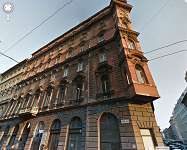
I believe I am the last surviving resident of the former yellow-star house at Király Street 85. I was born Veronika Lia Fried, and lived with my parents on the fourth floor in apartment no. 2. I was 8 years old then, and attended the Szív Street elementary school.
My father József Fried was on forced labor service. My mother was practical and decided to move the family living in Óbuda into our two-room apartment. Her thinking was that the Danube was an important dividing line, in case of expected deportation. She was right. The family members in Óbuda would already have been removed from the house on Tímár Street long ago, if they hadn’t moved to the seventh district.
The family grew: two grandmothers, an aunt and uncle and my beloved cousin moved in with us. In fact the apartment next door took in one of my cousins on my father’s side, a boy the same age as me, whose father was also on forced labor service. (My paternal grandmother had 13 children, of whom 9 reached adulthood. Their ages ranged widely, so it was possible for the various generations to overlap one another in age.)
I remember that the house was very full. But I also remember clearly that there was hardly any malicious gossip or argument. Even those neighbors understood each other who had not belonged to the same “caste.” The street-facing large middle-class apartments on the first three floors were all occupied like this, floors 4-5 were a new addition with more modern apartments. Shared hardship brought people together.
The residents were mostly intellectuals, as far as I know there weren’t any exceptionally rich or higher-ranking people there. On the other hand, there were lots of talented musical families. The Lehel family lived on the fifth floor, the choirmaster György Lehel, his parents and younger sister. My mother also had a degree in music. To this day I proud to remember those chamber music evenings where László Lehel played violin, my mother accompanied him, and Oli Schwartz (later Olga Szőnyi) sang. Zsuzsa Osvát and her sister Kati studied with the children.
It would be dishonest to long for those terrible times, the bombings, the adults’ anxieties, but for us children, the community offered calm. This “idyll” was immediately shattered by Szálasi coming to power, which meant that after October 15, the residents had to move on again, 2 or 3 houses away, leaving their humble belongings behind, and from there to the Wesselényi Street ghetto or a protected house. But that’s another story. I couldn’t follow it, only survive it at the age of 8-9.
Greetings: V. D.
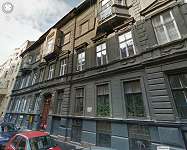
When I hear of 1944, or the word Holocaust, it’s always the pictures that have remained from those times that come to mind. It’s the same with the “yellow-star house.” I was a six-year-old boy and we lived in Lovag Street 18 on the first floor, at the back. It might sound strange but I was pleased that there was a star on the house because it meant we didn’t have to move. Three of us lived in the small apartment, me, my mother and grandmother. Father wasn’t at home, he had to join up somewhere. The only thing I can remember from the June-October period was that we had to wear the yellow star, even when in early September I went with my mother around the local schools, but they didn’t let us through the gate. “Why can’t we go in?” “Because of the star, my son.” “So let’s take it off.” “I’m afraid we can’t.”
The next image is from October 15. (It was only as an adult that I learned what kind of day that was.) We were travelling on the tram to Buda without the star, because my mother thought we didn’t need to wear it any more. The next day, it was back on us again.
Another flash of memory: I’m standing in the corridor opposite the gate, and men in black clothes with rifles come in. They talk to the house supervisor lady who points out our apartment to them. They look my mother away and later my grandmother too. An elderly couple took me in. I called them Auntie and Uncle. Together, we left the yellow-star house and went to a protected house on Váci Street (of course, I only learned later what this was.) I know now that it protected us from nothing. Soon we were driven along Jókai Street to Klauzál Square. This is where and when the ghetto started. Lots of other pictures flash in my mind, but that’s another story. The yellow-star house story lasts until that point. György Solt (then Schmideg) recalls those times 70 years ago.
2014. January 30., Thursday
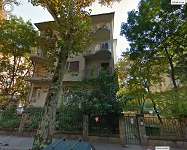
With my mother and older sister, we moved into the yellow-star house at Abonyi Street 5 in the 14th district in July 1944. Next door was the former Jewish grammar school, where there was a military barracks. As children, we didn’t feel our lives were in danger until we moved into the ghetto or protected house.
When it was dark, my mother got me, aged 10, and my 13-year-old sister over the fence and into the former grammar school, which had been appointed as a Red Cross house. There were still a few soldiers left there, making black coffee in a great kettle. These nice soldiers offered us a mug of coffee.
The school gym had been converted to house refugees, and there were 80 of us in there. Imre Ráday and Zsuzsa Simon were also there. Auntie Zsuzsa gathered all the children around her and told us poems. Perhaps it’s since then that I love literature.
We were liberated around January 15, 1945, but in the meantime, there were two Arrow Cross raids, and they took away lots of men and a few families. We were hidden in what was called the “knitting shop,” where there were school benches. I settled onto one of the benches. We heard an Arrow Cross man trying to come in, he’d already turned the door handle, the adult Jews were silently praying, and all of a sudden the door handle was released. I still have many painful memories from those times, but my mother’s love let me forget the terrible situation. We sometimes played there too, forgetting where we were. Captain Ocskay saved the remainder of the refugees at the grammar school.
Regards, Györgyi Róth (80-year-old teacher)
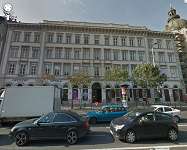
In this house at Bajcsy-Zsilinszky (then Emperor Vilmos) Street 16 lived my grandfather, a mechanical engineer, and his family. At the end of October 1944, the Arrow Cross came to take away the Jews. My grandmother and her daughter were hidden by the Calvinist minister János Viktor at the Szabadság Square Calvinist church (which is where, as an irony of history, a statue of Horthy has now been erected), but my grandfather remained in the apartment. The Arrow Cross didn’t know he was there, and were about to leave when the house when the concierge said to them, “There’s one more up there, don’t forget!” And so he was taken away too, first to the Óbuda brick factory, and then to somewhere near Kőszeg, where he disappeared. After the war, my grandmother and her children returned, and lived here until the 1950s.